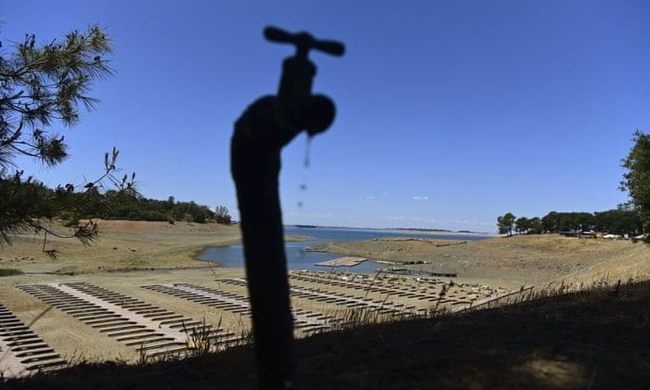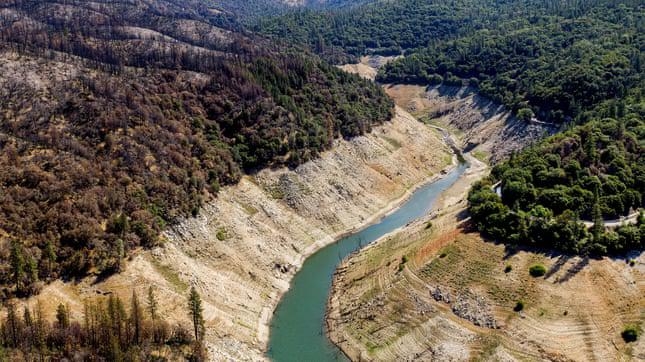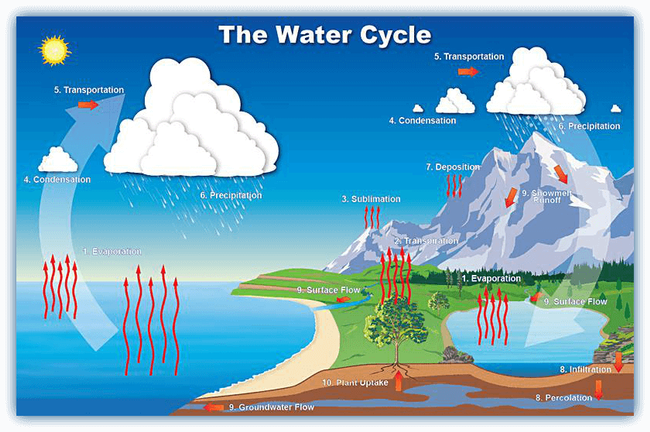Water is the most vital resource on our planet; a person can survive for nearly a month without food, but one may die without water in less than a week. Generally speaking, in every cultural ecosystem, water is heavily inscribed with social, spiritual, political, and environmental meaning, and these have a powerful effect upon a pattern of water use.
We depend upon water to survive, and we are closely entwined to tiny water molecules moving around our world. Throughout history, we have come to rely upon seasonal rain, snowmelt from mountains, and water recharging our underground reservoirs. As a result, the sites in which cities and entire civilizations have developed have been determined by the location and profusion of freshwater resources. Therefore, water is crucial for all people regardless of class and culture and the tremendous diversity of plants and animals that count on it for their daily survival.

The Earth's water cycle began 3.8 billion years ago when rain fell on a cooling Earth, forming the oceans. The rain came from water vapor that escaped the magma in the Earth's molten core into the atmosphere. Energy from the sun helped power the water cycle, and Earth's gravity kept water in the atmosphere from leaving the Planet. Consequently, the water cycle is the continuous process that connects all that water. It joins the Earth's oceans, land, and atmosphere.
Frequently, Earth is called the "Water Planet," and most people usually think there is plenty of water to go around. However, it is imperative to understand that NO new water is created during the water cycle. All of our water on Earth is recycled, and there is a limited amount of fresh water available in the world. Of all the water on Earth, more than 99% is unusable by humans and many other living things. However, from all of the water present on Earth, only 3% of Earth's water is freshwater. The U.S. Geological Survey states that a large portion of the 3% of freshwater is inaccessible. More than 68% of the planet's freshwater reside in icecaps and glaciers and less than 30% in groundwater. Only 0.3% of our freshwater is in the surface water of lakes, rivers, and swamps.
So, given its tiny proportions on Earth, freshwater is a vital global issue. Indeed, it seems surprising that freshwater so essential to support life on Earth is in short supply. Therefore, with this knowledge comes an understanding that we have to utilize this resource very wisely.
Climate Change
According to NASA, the most severe Earth science and environmental policy issues threatening civilization are the possible changes in the Earth's water cycle due to climate change. The science community now largely agrees that the Earth's climate is experiencing changes in response to natural fluctuations, including solar variability and increased concentrations of greenhouse gases and aerosols. These changes may deeply affect atmospheric water vapor concentrations, clouds, precipitation patterns, and runoff and streamflow patterns.

A region's temperature also relies on the water cycle. Through the water cycle, heat is exchanged and temperatures fluctuate. As water evaporates, for example, it absorbs energy and cools the local environment. As water condenses, it realizes energy and warms the local environment.
How Climate Change is Affecting the Water Cycle and Water Availability in California.
California has a "Mediterranean climate," with hot, dry summers and mild, wet winters. For many years, this environment has remained relatively stable. However, our climate is changing; we have seen the average annual temperature increase steadily since 1895, with the rate of warming accelerating since the mid-1970s.
At the same time, freezing level elevation has risen by about 500 feet, and winter chill time, essential for many fruit trees to produce flowers and fruit, has decreased. Extreme heat events have also increased in duration and frequency. Our water resources also show signs of stress. Spring snowmelt runoff has decreased, indicating warmer winter temperatures and more precipitation falling as rain rather than snow. Sea levels have also risen over the past century; 8 inches recorded in the bay area of California.

Drought "It is not just how much precipitation you get-it is also about whether or not it stays in the ground."
UC Davis states that California is no stranger to drought; it is a recurring feature of California climate.
Drought is described as a lengthy dry weather produced by the lack of precipitation, creating severe water shortages for some activity, population, or ecological systems. Drought is also thought of as an extended imbalance between precipitation and evaporation. According to the Department of Water Resources (DWR), drought is based on water users' impacts. Furthermost, people think of a drought as a hot, dry weather condition with little to no rain or snow. However, drought is not just a weather phenomenon. Drought can also happen when supplies can't keep up with demand. Drought impacts vary with locations, and it is felt first by people most dependent on rainfall, such as landowners using dryland range or rural populations relying on wells in a low-yield rock formation. Drought impact increases with the length of a drought, as surplus supplies in reservoirs are depleted and water levels in the groundwater basins decline.
Drought also causes public and safety health issues, as well as economic and environmental impacts. Public and safety health impacts are correlated with devastating wildfire risks and drinking water shortage risks for small water systems and private residential wells in rural areas. Other impacts include the cost to homeowners due to loss of residential landscaping; degradation of urban environment due to loss of landscaping; agricultural land left fallow, and associated job loss; deterioration of fisheries habitat; and tree mortality with damage to forest ecosystems.
Climate change affects California's water resources as evidenced by changes in snowpack, sea levels, and river flows. As we seek to adapt to and mitigate the impact of climate change, responsible management of California's water resources is essential for the long-term health of our state.
Helpful hints to help reduce water use outside your home.
Use water-wise plants, check with your local water agency on the best plants for your area. It is best to use water-wise, California-native plants. Installing drip irrigation and adding a smart controller can save 15 gallons each time you water. Use a broom to clean outdoor areas to save 18 gallons every day. Use drought-resistant trees and plants that save 30-60 gallons per 1000 sq. ft. each watering. Set your mower blades to 3", which encourages deep roots, and save 16-50 gallons per day. Adjust Sprinkler heads and fix leaks which saves 12-15 gallons each time you water.
For more information please visit:
https://www.nationalgeographic.org/
https://earthobservatory.nasa.gov/
https://www.watereducation.org/